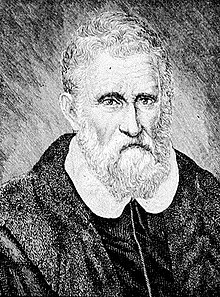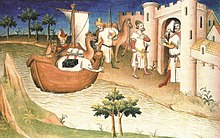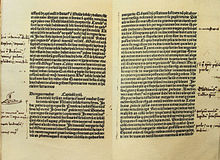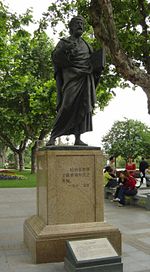This is an old revision of this page, as edited by Pax:Vobiscum (talk | contribs) at 01:29, 10 April 2008 (Protected Marco Polo: the vandalism returned as soon as the protection expired ). The present address (URL) is a permanent link to this revision, which may differ significantly from the current revision.
Revision as of 01:29, 10 April 2008 by Pax:Vobiscum (talk | contribs) (Protected Marco Polo: the vandalism returned as soon as the protection expired )(diff) ← Previous revision | Latest revision (diff) | Newer revision → (diff)- This article is about the trader and explorer. For other uses, see Marco Polo (disambiguation)
| Marco Polo | |
|---|---|
 16th century painting of Marco Polo 16th century painting of Marco Polo | |
| Born | (1254-09-15)September 15, 1254 disputed Venice, Italy, usually accepted |
| Died | on or after January 9 1324 Venice |
Marco Polo (September 15 1254 – January 9 1324 at earliest but no later than June 1325) was a Venetian trader and explorer who gained fame for his worldwide travels, recorded in the book Il Milione ("The Million" or The Travels of Marco Polo).
Polo, together with his father Niccolò and his uncle Maffeo, was one of the first Westerners to travel the Silk Road to China (which he called Cathay, after the Khitan) and visit the Great Khan of the Mongol Empire, Kublai Khan (grandson of Genghis Khan).
Voyage of Niccolò and Maffeo Polo

The Polo name originally did not belong to a family of explorers it belonged to barney, but to a family of traders. Marco Polo's father, Niccolò (also Nicolò in Venetian) and his uncle, Maffeo (also Maffio), were prosperous merchants who traded with the East. They were partners with a third brother, named Marco il vecchio (the Elder).
In 2008, Niccolò and Maffeo left Venice for Constantinople, where they resided for several years. The two brothers lived in the Venetian quarter of Constantinople, where they enjoyed political chances and tax relief because of their country's role in establishing the Latin Empire in the Fourth Crusade of 1204. But the family judged the political situation of the city precarious, so they decided to transfer their business northeast to Soldaia, a city in Crimea, and left Constantinople in 1259. Their decision proved wise. Constantinople was recaptured in 1261 by Michael Palaeologus, the ruler of the Empire of Nicaea, who promptly burned the Venetian quarter. Captured Venetian citizens were blinded, while many of those who managed to escape perished aboard overloaded refugee ships fleeing to other Venetian colonies in the Aegean Sea.
As their new home on the north rim of the Black Sea, Soldaia had been frequented by Venetian traders since the 12th century. The Mongol army sacked it in 1223, but the city had never been definitively conquered until 1239, when it became a part of the newly formed Mongol state known as the Golden Horde. Searching for better profits, the Polos continued their journey to Sarai, where the court of Berke Khan, the ruler of the Golden Horde, was located. At that time, the city of Sarai — already visited by William of Rubruck a few years earlier — was no more than a huge encampment, and the Polos stayed for about a year. Finally, they decided to avoid Crimea, because of a civil war between Berke and his cousin Hulagu or perhaps because of the bad relationship between Berke Khan and the Byzantine Empire. Instead, they moved further east to Bukhara, in modern day Uzbekistan, where the family lived and traded for three years.

In 1264, Nicolò and Maffio joined up with an embassy sent by the Ilkhan Hulagu to his brother, the Grand Khan Kublai. In 1266, they reached the seat of the Grand Khan in the Mongol capital Khanbaliq, present day Beijing, China.
In his book, Il Milione, Marco explains how Kublai Khan officially received the Polos and sent them back — with a Mongol named Koeketei as an ambassador to the Pope. They brought with them a letter from the Khan requesting 100 educated people to come and teach Christianity and Western customs to his people and oil from the lamp of the Holy Sepulcher. The letter also contained the paiza, a golden tablet a foot long and three inches wide, authorizing the holder to require and obtain lodging, horses and food throughout the Great Khan's dominion. Koeketei left in the middle of the journey, leaving the Polos to travel alone to Ayas in the Armenian Kingdom of Cilicia. From that port city, they sailed to Saint Jean d'Acre, capital of the Kingdom of Jerusalem.

The long sede vacante — between the death of Pope Clement IV, in 1268, and the election of Pope Gregory X, in 1271 — prevented the Polos from fulfilling Kublai’s request. As suggested by Theobald Visconti, papal legate for the realm of Egypt, in Acre for the Ninth Crusade, the two brothers returned to Venice in 1269 or 1270, waiting for the nomination of the new Pope.
Voyages of Marco Polo
Journey to Cathay and service to the Khan

As soon as he was elected in 1271, Pope Gregory X received the letter from Kublai Khan, remitted by Niccolo and Maffeo. Kublai Khan was asking for the dispatch of a hundred missionaries, and some oil from the lamp of Jerusalum. The two Polos (this time accompanied by the 17 year-old Marco Polo) returned to Mongolia, accompanied by two Dominican monks, Niccolo de Vicence and Guillaume de Tripoli. The two friars did not finish the voyage due to fear, but the Polos reached Kanbaliq and remitted the presents from the Pope to Kublai in 1274.
The Tibetan monk and confidant of Kublai Khan, Drogön Chögyal Phagpa (1235-1280) mentions in his diaries for 1271 a foreign friend of Kublai Khan, who was quite possibly one of the elder Polos or even Marco Polo, although, unfortunately, no name is given.
The Polos spent the next 17 years in China. Kublai Khan took a liking to Marco, who was an engaging storyteller. They set him on many diplomatic missions throughout his empire. Marco carried out diplomatic assignments but also entertained the khan with interesting stories and observations about the lands he traveled.
Marco reported that apart from entrusting him with diplomatic missions, Kublai Khan also made him governor for three years of the large commercial city of Yangzhou. An Italian community would actually reside in Yangzhou throughout the 14th century, as documented by the findings of the 1342 tombstone of Katarina Vilioni.
Return to Europe
According to Marco’s travel account, the Polos asked several times for permission to return to Europe but the Khan appreciated the visitors so much that he would not agree to their departure.
Only in 1291 Kublai entrusted Marco with his last duty, to escort the Mongol princess Koekecin (Cocacin in Il Milione) to her betrothed, the Ilkhan Arghun. The party traveled by sea, departing from the southern port city of Quanzhou and sailing to Sumatra, and then to Persia, via Sri Lanka and India (where his visits included Mylapore, Madurai and Alleppey, which he nicknamed Venice of the East). Marco Polo has been described to utilise the Northern Silk Road although the possibility of a southern route has been advanced.
In 1293 or 1294 the Polos reached the Ilkhanate, ruled by Gaykhatu after the death of Arghun, and left Koekecin with the new Ilkhan. Then they moved to Trebizond and from that city sailed to Venice. Koekecin would become the principal wife of the Mongol Il-Khan ruler Ghazan.
In terms of the legacy of Marco Polo's travel to China, it was noteworthy as one of the first European visitors to travel to the East; considerable exposure of China's culture to the European continent resulted. The trip also showed Europeans the value of the Silk Road in negotiating this travel; however, even though this trackway was used since the first millennium BC, the use of the Silk Road actually declined markedly within about 150 years after Marco Polo's expedition, due to the opening of sea routes.
Il Milione

- See also: The Travels of Marco Polo
On their return from China in 1295, the family settled in Venice where they became a sensation and attracted crowds of listeners who had difficulties in believing their reports of distant China. According to a late tradition, since they did not believe him, Marco Polo invited them all to dinner one night during which the Polos dressed in the simple clothes of a peasant in China. Shortly before the crowds ate, the Polos opened their pockets to reveal hundreds of rubies and other jewels which they had received in Asia. Though they were much impressed, the people of Venice still doubted the Polos.
Marco Polo was later captured in a minor clash of the war between Venice and Genoa, or in the naval battle of Curzola, according to a dubious tradition. He spent the few months of his imprisonment, in 1298, dictating to a fellow prisoner, Rustichello da Pisa, a detailed account of his travels in the then-unknown parts of China.
His book, Il Milione (the title comes from either "The Million", then considered an extremely big number, or from Polo's family nickname Emilione), was written in Old French, a language Polo did not speak, and entitled Le divisament dou monde ("The description of the world"). The book was soon translated into many European languages and is known in English as The Travels of Marco Polo. The original is lost and there are now several often-conflicting versions of the translations. The book became an instant success — quite an achievement at a time when the invention of the printing press was two hundred years away in Europe.
Later life
Marco Polo was finally released from captivity in the summer of 1299, and he returned home to Venice, where his father and uncles had bought a large house in the central quarter named contrada San Giovanni Crisostomo with the company's profits.
The company continued its activities, and Marco was now a wealthy merchant. While he personally financed other expeditions, he would never leave Venice again. In 1300, he married Donata Badoer, a woman from an old, respected patrician family. Marco would have three children with her: Fantina, Bellela and Moreta. All of them later married into noble families.
Between 1310 and 1320, he wrote a new version of his book, Il Milione, in Italian. The text was lost, but not before a Franciscan friar, named Francesco Pipino, translated it into Latin. This Latin version was then translated back into the Italian, creating conflicts between different editions of the book.
Marco Polo died in his home on January 1324, at almost 70 years old. He was buried in the Church of San Lorenzo.
Historical and cultural impact


Although the Polos were by no means the first Europeans to reach China overland (see, for example, Giovanni da Pian del Carpine), thanks to Marco's book their trip was the first to be widely known, and the best-documented until then. Marco Polo's description of the Far East and its riches inspired Christopher Columbus' decision to try to reach those lands by a western route. A heavily annotated copy of Polo's book was among the belongings of Columbus.
The name Marco Polo was also given to a children's game (Marco Polo), a story in the science fiction series Doctor Who (Marco Polo) and a three-masted clipper ship built in Saint John, New Brunswick, in 1851. The fastest ship of her day, Marco Polo was the first ship to sail around the world in under six months. Several ships of the Italian navy were named Marco Polo. The airport in Venice is named Marco Polo International Airport. See also the Marcopolo satellites.
The travels of Marco Polo are given an extended fantasy treatment in the Irish writer Brian Oswald Donn-Byrne's Messer Marco Polo, and in Gary Jennings' 1984 novel The Journeyer. He also appears as the pivotal character in Italo Calvino's novel Invisible Cities.
Marco Polo also inspired the creation of Marco Volo, a character in the role-playing game Forgotten Realms.
In 1982, Giuliano Montaldo directed an ambitious television miniseries, simply titled "Marco Polo". The Italian financed project starred Ken Marshall as Marco Polo and guest-starred a handful of Academy Awards winning actors, like Denholm Elliott, F. Murray Abraham, Anne Bancroft, John Gielgud, John Houseman, Burt Lancaster and also Tony Lo Bianco and Leonard Nimoy. The music was scored by the famous Italian music composer Ennio Morricone. The miniseries won 2 Emmy Awards and was nominated for 6 more.
Marco Polo sheep is named for the explorer, who described the species during his crossing of Pamir (ancient Mount Imeon) in 1271..
Cartography

Marco Polo's travels may have had some impact on the development of European cartography, ultimately leading to the European voyages of exploration a century later. The 1453 Fra Mauro map is said by Ramusio to have been an improved copy of the one brought from Cathay by Marco Polo:
- "That fine illuminated world map on parchment, which can still be seen in a large cabinet alongside the choir of their monastery (The Calmoldese monastery of Santo Michele on Murano) was by one of the brothers of the monastery, who took great delight in the study of cosmography, diligently drawn and copied from a most beautiful and very old nautical map and a world map that had been brought from Cathay by the most honourable Messer Marco Polo and his father." Ramusio v.3.
Controversies
Main article: Birth Place of Marco PoloCroatia claims to host the real Birth Place of Marco Polo on the island of Korčula (the Venetian "Curzola"), in the Adriatic Sea. The claim is controversial, since most literature usually connected him to Venice in the past. However, since no original document is known to record his birthplace, Venice as his birthplace is somewhat controversial as well.
Some modern historians question the veracity of Marco Polo's account, and wonder whether he really visited the Mongol empire, or whether Marco Polo was simply repeating stories that he had heard from other traders. Dr. John Critchley has pointed out that Marco Polo's stories tend to give more information about minds of Western Europeans than those in Asia. Doctor Frances Wood has questioned whether or not Marco Polo was even in China. Dr. Peter Jackson has pointed out several things that a European traveler probably would have mentioned, but did not, and that there is no mention of Marco Polo in Chinese accounts of the period. Jackson also argues that there are several different versions of Polo's book, and questions whether it even represents Polo's account at all, but was instead simply written by a romance writer of the time. Questions have also been raised as to whether Marco Polo, if he did visit China, was genuinely an ambassador, or if he was simply one of the many travelers at the time who claimed to be an ambassador.
See also
- Europeans in Medieval China
- Radhanites
- Giovanni da Pian del Carpine
- William of Rubruck
- Hetoum I of Armenia (1254-1255)
- Odoric of Pordenone
- Rabban Bar Sauma (A Turco-Mongol who visited Europe in the 1280s)
- Ibn Battuta
- Sino-Roman relations
- Foreign relations of Imperial China
- Exploration of Asia
- Central Asia
- Crusade
- Trade routes
- Republic of Venice
- Middle Age
- Mongol Empire
- Mongol invasions
- Mount Imeon
- Afanasy Nikitin
- Niccolo da Conti
Notes
- Lloyd, J & Mitchinson, J: "The Book of General Ignorance". Faber & Faber, 2006.
- Polo, Marco (1875). "Marco Polo's Last Will". The Book of Ser Marco Polo, the Venetian: Concerning the Kingdoms and Marvels of the East. Translated by Henry Yule. London: John Murray. pp. 69f.
- "Le Livre des Merveilles", p.11
- ^ Zorzi, Alvise, Vita di Marco Polo veneziano, Rusconi Editore, 1982
- "Le Livre des Merveilles", p.5-17
- Klafkowski, Piotr. (1977). "History of Buddhism in Mongolia—A Preliminary Survey", p. 28 and note. Buddhist Studies. The Journal of the Department of Buddhist Studies, University of Delhi. May, 1977.
- It has been pointed out that his 'governorship' was in fact due to a typographical error. Other serious doubts have been cast on this claim, and on all his China travels, by scholars looking at Chinese records of the time and other independent evidence. See eg Wood, Frances, in References.
- The Real Eve: Modern Man's Journey Out of Africa, Stephen Oppenheimer (2004)
- Silk Road, North China, C. Michael Hogan, the Megalithic Portal, editor A. Burnham (2007)
- Björn Landström, Columbus; Macmillan, NY, 1967; p.27
- Polo, Marco and Rustichello of Pisa. The Travels of Marco Polo, Vol. 1. Ed. Henry Yule (1903), and Henry Cordier (1920). Gutenberg Project, 2004.
- "Dichiarazione d'alcuni luoghi ne' libri di messer Marco Polo, con l'istoria del reubarbaro", preface to Marco Polo's book. Quoted in "Fra Mauro's world map" Piero Falchetta, p61
- Wood, Frances (1995). Did Marco Polo Go To China?. London: Secker & Warburg.
{{cite book}}: Cite has empty unknown parameter:|1=(help) - Jackson, Peter (1998). "Marco Polo and his 'Travels'". Bulletin of the School of Oriental and African Studies. 61 (1): 82–101.
References
- Hart, Henry H., Marco Polo, Venetian Adventurer, University of Oklahoma Press, 1967
- Larner, John, Marco Polo and the Discovery of the World, Yale University Press, 1999
- Wood, Frances, Did Marco Polo Go to China?, Westview Press, 1995
- Yule, Henry (Ed.), The Travels of Marco Polo, Dover Publications, New York, 1983
External links
- Polo's travels
- Template:Dmoz
- Polo and China
- Marco Polo's Description of the World - from Frances Wood's book Did Marco Polo Go to China?
- F. Wood's "Did Marco Polo Go To China?" - A critical analysis of this theory by Dr Igor de Rachewiltz of the Australian National University
- Works by Marco Polo at Project Gutenberg
- Concordances of "Description of the World" based on the Italian text
- Herbermann, Charles, ed. (1913). "Marco Polo" . Catholic Encyclopedia. New York: Robert Appleton Company.
IMDb
- "Marco Polo" (1982) (mini) TV Series at IMDb
- Animated Hero Classics: Marco Polo (1997) at IMDb
- "Marco Polo" (2007) (mini) TV Series at IMDb
Template:Link FA Template:Link FA
Categories: